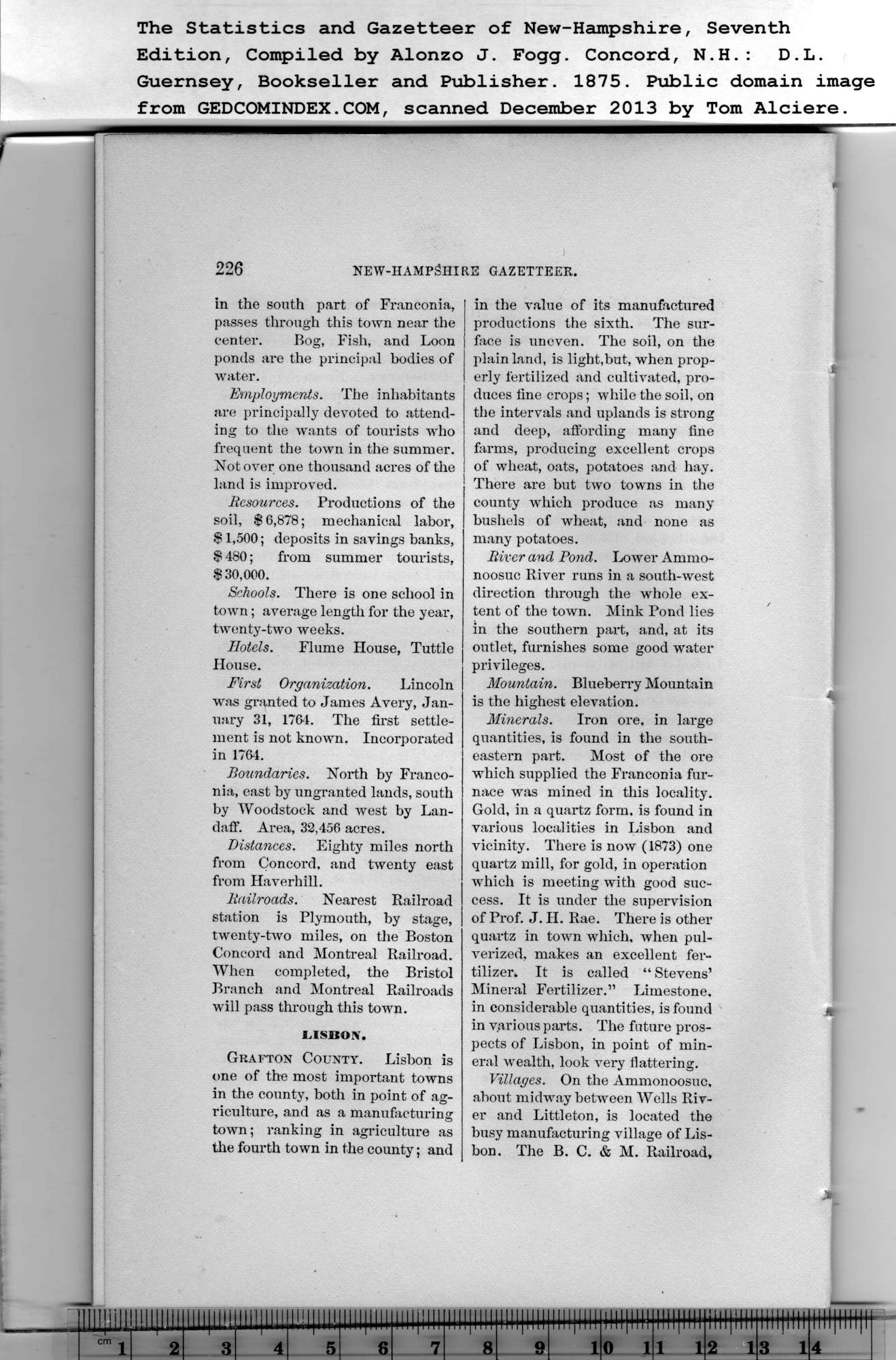|
226
The Statistics and Gazetteer of New-Hampshire, Seventh
Edition, Compiled by Alonzo J. Fogg. Concord, N.H.: D.L.
in the south part of Franconia,
passes through this town near the
center. Dog, Fish, and Loon
ponds are the principal bodies of
water.
Employments. The inhabitants
are principally devoted to attend-
ing to the wants of tourists who
frequent the town in the summer.
Not over one thousand acres of the
land is improved.
Resources. Productions of the
soil, $6,878; mechanical labor,
$ 1,500; deposits in savings banks,
$480; from summer tourists,
$30,000.
Schools. There is one school in
town; average length for the year,
twenty-two weeks.
Hotels. Flume House, Tuttle
House.
First Organization. Lincoln
was granted to James Avery, Jan-
uary 31, 1764. The first settle-
ment is not known, Incorporated
in 1764.
Boundaries. North by Franco-
nia, east by ungranted lands, south
by Woodstock and west by Lan-
daff. Area, 32,456 acres.
Distances. Eighty miles north
from Concord, and twenty east
from Haverhill.
Railroads. Nearest Railroad
station is Plymouth, by stage,
twenty-two miles, on the Boston
Concord and Montreal Railroad.
When completed, the Bristol
Branch and Montreal Railroads
will pass through this town.
LISBON. |
Grafton County. Lisbon is
one of the most important towns
in the county, both in point of ag-
riculture, and as a manufacturing
town; ranking in agriculture as
the fourth town in the county; and
in the value of its manufactured
productions the sixth. The sur-
face is uneven. The soil, on the
plain land, is light,but, when prop-
erly fertilized and cultivated, pro-
duces fine crops; while the soil, on
the intervals and uplands is strong
and deep, affording many fine
farms, producing excellent crops
of wheat, oats, potatoes and hay.
There are but two towns in the
county which produce as many
bushels of wheat, and none as
many potatoes.
River and Pond. Lower Ammo-
noosuc River runs in a south-west
direction through the whole ex-
tent of the town. Mink Pond lies
in the southern part, and, at its
outlet, furnishes some good water
privileges.
Mountain. Blueberry Mountain
is the highest elevation.
Minerals. Iron ore, in large
quantities, is found in the south-
eastern part. Most of the ore
which supplied the Franconia fur-
nace was mined in this locality.
Gold, in a quartz form, is found in
various localities in Lisbon and
vicinity. There is now (1873) one
quartz mill, for gold, in operation
which is meeting with good suc-
cess. It is under the supervision
of Prof. J. H. Rae. There is other
quartz in town which, when pul-
verized, makes an excellent fer-
tilizer. It is called “ Stevens’
Mineral Fertilizer.” Limestone,
in considerable quantities, is found
in various parts. The future pros-
pects of Lisbon, in point of min-
eral wealth, look very flattering.
Villages. On the Ammonoosuc,
about midway between Wells Riv-
er and Littleton, is located the
busy manufacturing village of Lis-
bon. The B. C. & M. Railroad, |
